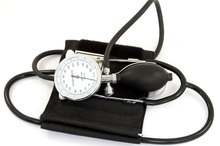Diastolic Blood Pressure During Exercise
Blood pressure measurements tell you how strongly your blood is pushing against arterial walls. Diastolic pressure measures the force of your blood when your heart is at rest between contractions. This measurement usually shows little or no change during exercise, although it can vary, depending on factors such as your body position during exercise, the type of exercise and whether you have heart-related problems.
Effects of Exercise
If your blood pressure reading is 130/90 (expressed in mm Hg, or millimeters of mercury), 130 is your systolic pressure -- the pressure in your arteries when your heart contracts -- and 90 is your diastolic pressure. During aerobic exercise, systolic pressure should gradually increase as your heart beats harder and faster and your arteries contract to pump more oxygen-rich blood. However, because the arteries in your working muscles start to dilate rather than constrict, the net result is little change in your diastolic pressure. There may even be a slight decrease if you are working at a less than maximum heart rate. At your maximum rate, your diastolic pressure may rise slightly.
Abnormal Increases
How Does Blood Pressure Respond to Isometric Exercise?
Learn More
A rise in diastolic blood pressure of more than 10 to 15 mmHg during exercise may indicate an unstable form of hypertension related to coronary artery disease. If the increase in pressure is accompanied by chest pain, the disease is probably more severe, according to researchers at King's College and Lewisham Hospitals in London, England. Different medications can also cause variable blood pressure responses to exercise.
Exercise During Hypertension
Normal blood pressure is no higher than 120/80 mmHg. If you have elevated blood pressure, your doctor may recommend you start a program of regular aerobic exercise, such as walking or bicycling. Even if you have higher blood pressure, you can benefit from starting with shorter sessions of 10 minutes each, gradually working up from there. Your doctor may have you first undergo stress testing to monitor your heart during exercise. If weight training, lift lighter weights more times; heavier weights cause a bigger increase in blood pressure.
Exercise During Hypotension
How Long for Your Blood Pressure to Return to Normal After Running?
Learn More
If your blood pressure is lower than 90/60, you have low blood pressure. Although athletes can have lower blood pressure than normal, if yours is abnormally low, you may have problems such as a heart valve condition, a very slow heart rate or a hormonal disorder. Intense exercise and sudden changes in position may be dangerous. Your blood pressure may drop further when blood vessels to your muscles dilate. This decreases blood flow to the brain, which may result in dizziness and fainting.
Related Articles
References
- Physiology of Sport and Exercise; W. Larry Kenney
- Hypertension: Progressive Resistance Exercise and Resting Blood Pressure
- British Heart Journal: Increased Diastolic Blood Pressure Response to Exercise Testing When Coronary Artery Disease Is Suspected
- MayoClinic.com: High Blood Pressure
- MayoClinic.com: Low Blood Pressure
Writer Bio
Lexa W. Lee is a New Orleans-based writer with more than 20 years of experience. She has contributed to "Central Nervous System News" and the "Journal of Naturopathic Medicine," as well as several online publications. Lee holds a Bachelor of Science in biology from Reed College, a naturopathic medical degree from the National College of Naturopathic Medicine and served as a postdoctoral researcher in immunology.








